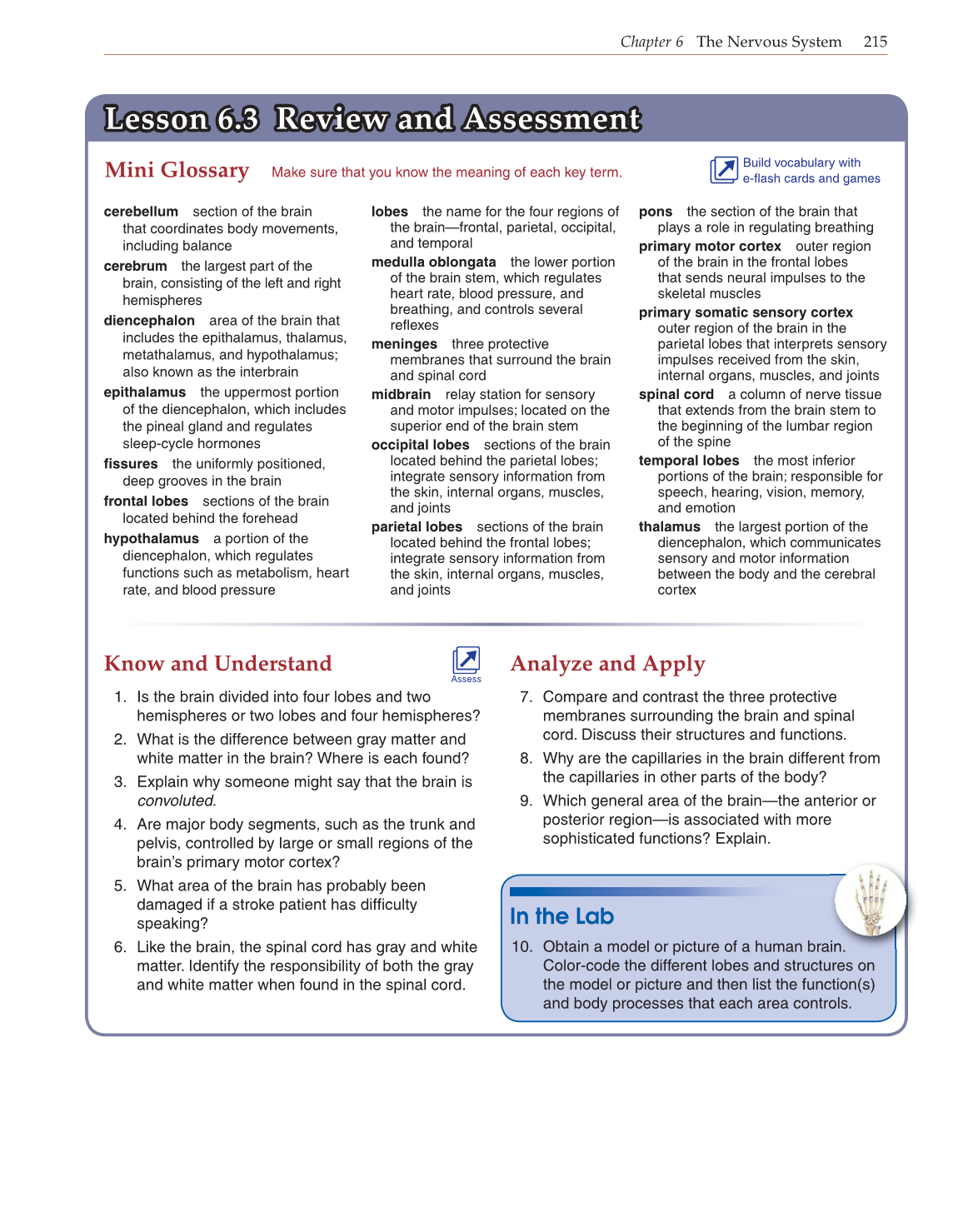Chapter 6 The Nervous System 215
Lesson 6.3 Review and Assessment Lesson 6.3 Review and Assessment
Mini Glossary
Make sure that you know the meaning of each key term.
cerebellum section of the brain
that coordinates body movements,
including balance
cerebrum the largest part of the
brain, consisting of the left and right
hemispheres
diencephalon area of the brain that
includes the epithalamus, thalamus,
metathalamus, and hypothalamus;
also known as the interbrain
epithalamus the uppermost portion
of the diencephalon, which includes
the pineal gland and regulates
sleep-cycle hormones
fi ssures the uniformly positioned,
deep grooves in the brain
frontal lobes sections of the brain
located behind the forehead
hypothalamus a portion of the
diencephalon, which regulates
functions such as metabolism, heart
rate, and blood pressure
lobes the name for the four regions of
the brain—frontal, parietal, occipital,
and temporal
medulla oblongata the lower portion
of the brain stem, which regulates
heart rate, blood pressure, and
breathing, and controls several
refl exes
meninges three protective
membranes that surround the brain
and spinal cord
midbrain relay station for sensory
and motor impulses; located on the
superior end of the brain stem
occipital lobes sections of the brain
located behind the parietal lobes;
integrate sensory information from
the skin, internal organs, muscles,
and joints
parietal lobes sections of the brain
located behind the frontal lobes;
integrate sensory information from
the skin, internal organs, muscles,
and joints
pons the section of the brain that
plays a role in regulating breathing
primary motor cortex outer region
of the brain in the frontal lobes
that sends neural impulses to the
skeletal muscles
primary somatic sensory cortex
outer region of the brain in the
parietal lobes that interprets sensory
impulses received from the skin,
internal organs, muscles, and joints
spinal cord a column of nerve tissue
that extends from the brain stem to
the beginning of the lumbar region
of the spine
temporal lobes the most inferior
portions of the brain; responsible for
speech, hearing, vision, memory,
and emotion
thalamus the largest portion of the
diencephalon, which communicates
sensory and motor information
between the body and the cerebral
cortex
Know and Understand
1. Is the brain divided into four lobes and two
hemispheres or two lobes and four hemispheres?
2. What is the difference between gray matter and
white matter in the brain? Where is each found?
3. Explain why someone might say that the brain is
convoluted.
4. Are major body segments, such as the trunk and
pelvis, controlled by large or small regions of the
brain’s primary motor cortex?
5. What area of the brain has probably been
damaged if a stroke patient has diffi culty
speaking?
6. Like the brain, the spinal cord has gray and white
matter. Identify the responsibility of both the gray
and white matter when found in the spinal cord.
Analyze and Apply
7. Compare and contrast the three protective
membranes surrounding the brain and spinal
cord. Discuss their structures and functions.
8. Why are the capillaries in the brain different from
the capillaries in other parts of the body?
9. Which general area of the brain—the anterior or
posterior region—is associated with more
sophisticated functions? Explain.
10. Obtain a model or picture of a human brain.
Color-code the different lobes and structures on
the model or picture and then list the function(s)
and body processes that each area controls.
In the Lab
in
Assess
Build vocabulary with
e-fl ash cards and games
